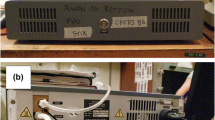Abstract
Chromatographic analyses of fumarolic gases, collected in sampling bottles containing an alkaline solution, have been carried out using a thermal conductivity detector and a flame ionization detector, after catalytic conversion of CO and CH4. The latter method enables the concentration of carbon monoxide to be measured with sufficient accuracy for use in a CO-CO2-H2-H2O geothermometer. Application of this geothermometer to fumaroles in the crater of Solfatara in the Campi Flegrei, Italy, indicates that they are fed from a steam reservoir at 250±15 °C and at 10−36±2atm of oxygen. On the other hand, the CH4-CO2-H2-H2O geothermobarometer seems to re-equilibrate at superficial temperatures and cannot be used for infering thermodynamic conditions at depth. Regular sampling of these fumaroles together with a geothermometric interpretation of the gas analyses provides a means of monitoring, with comparative accuracy, the chemical and thermal evolution of the hydrothermal reservoir below the Solfatara crater. Such monitoring would probably detect an increase in temperature at depth and the injection of magmatic gas into the reservoir.
Similar content being viewed by others
References
Allard P (1983) The origin of hydrogen, carbon, sulphur, nitrogen and rare gases in volcanic exhalations: evidence from isotope geochemistry. In: Forecasting Volcanic Events. Tazieff H, Sabroux JC (eds). Amsterdam, Elsevier pp 337–386
Barberi F, Corrado G, Innocenti F, Luongo G (1984) Phlegraean Fields 1982–1984: Brief chronicle of a volcano emergency in a densely populated area. Bull Volcano 47: 175–185
Barin I, Knacke O (1973) Thermochemical Properties of Inorganic Substances. Springer Berlin Heidelberg New York 921 p
Barin I, Knacke O (1977) Thermochemical Properties of Inorganic Substances. Springer Berlin Heidelberg New York 861 p
Carapezza M, Nuccio PM, Valenza M (1984) Geochemical surveillance of the Solfatara of Pozzuoli (Phlegraean Fields) during 1983. Bull Volcanol 47: 303–311
Cioni R, Corazza E (1981) Medium-temperature fumarolic gas sampling. Bull Volcanol 41: 23–29
Cioni R, Corazza E, Marini L (1984) The gas/steam ratio as indicator of heat transfer at the Solfatara fumaroles, Phlegraean Fields (Italy). Bull Volcanol 47: 295–302
D'Amore F, Panichi C (1980) Evaluation of deep temperatures of hydrothermal system by a new gas geothermometer. Geochim Cosmochim Acta 44: 549–556
Eugster HP, Wones DR (1962) Stability relations of the ferruginuous biotite, annite. J Petrol 3: 82–125
Giggenbach WF (1975) A simple method for collection and analysis of volcanic gases. Bull Volcanol 39: 132–145
Hass Jr JL (1970) Fugacity of H20 from 0 ° to 350 °C at the liquid-vapor equilibrium and at 1 atmosphere. Geochim Cosmochim Acta 34: 929–931
Hermance JF (1983) The Long Valley/Mono Basin volcanic complex in Eastern California: status of present knowledge and future research needs. Rev Geophys Space Phys 21: 1545–1565
Irvine TF, Hartnett JP (1976) Steam and Air Tables in SI Units. McGraw Hill, New York, 127 p
Istituto di Geocronologia e Geochimica Isotopica (CNR) (1984) Rapporto Osservatorio Vesuviano: Bradisismo Flegreo. Pisa 79 p
Marinelli G (1976) Geothermie et théories métallogénétiques. Ann Mines Belg 12: 1067–1074
Martini M, Cellini Legittimo P, Piccardi G, Giannini L (1984) Composition of hydrothermal fluids during the bradyseismic crisis which commenced at Phlegraean Fields in 1982. Bull Volcanol 47: 267–273
Matsuo S (1961) On the chemical nature of fumarolic gases of volcano Showa-shinzan, Hokkaido, Japan. J Earth Sci, Nagoya Univ 80–100
Matsuo S, Osaka J, Hirabayashi J, Ozawa T, Kimishima S (1982) Chemical nature of volcanic gases of Usu volcano in Japan. Bull Volcanol 45: 261–264
McKee CO, Johnson RW, Lowenstein PL, Riley SJ, Blong RJ, De Saint Ours P, Talai B (1985) Rabaul Caldera, Papua New Guinea: volcanic hazards, surveillance and eruption contingency planning. Bull Volcanol Geotherm Res 23: 195–237
Mestrel M (1983) Emissions de monoxide de carbone sur les sites geothermiques: etude du cas de Larderello (Italie). CFR 48 p unpublished report
Nuti S, Caprai A, Noto P (1985) Hypothesis on the origin of steam and on the deep temperature of the fluids of Pozzuoli Solfatara (Campania, Italy). In: 1985 International Symposium on Geothermal Energy, International Volume. Stone C (ed). Geothermal Resources Council
Piccardi G (1982) Fumaroles gas collection and analysis. Bull Volcanol 45: 257–260
Sabroux JC (1979) Equilibre thermodynamique en phase gazeuse volcanique. In: Hautes Temperatures et Sciences de la Terre, Toulouse, Editions du CNRS, pp 37–46
Sabroux JC (1983) Volcano energetics: volcanic gases and vapours as geothermometers and geobarometers. In: Forecasting Volcanic Events. Tazieff H, Sabroux JC (eds), Amsterdam, Elsevier pp 17–25
Wones DR, Gilbert MC (1969) The Fayalite-magnetite-quartz assemblage between 600 ° and 800 °C. Am J Sci 267-A: 480–488
Author information
Authors and Affiliations
Rights and permissions
About this article
Cite this article
Tedesco, D., Sabroux, J.C. The determination of deep temperatures by means of the CO-CO2-H2-H2O geothermometer: an example using fumaroles in the Campi Flegrei, Italy. Bull Volcanol 49, 381–387 (1987). https://doi.org/10.1007/BF01046631
Received:
Accepted:
Issue Date:
DOI: https://doi.org/10.1007/BF01046631




